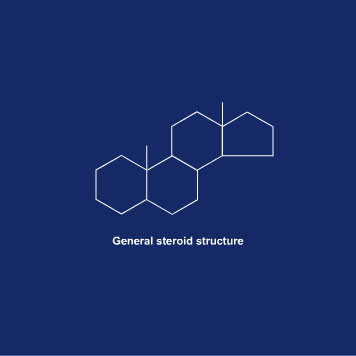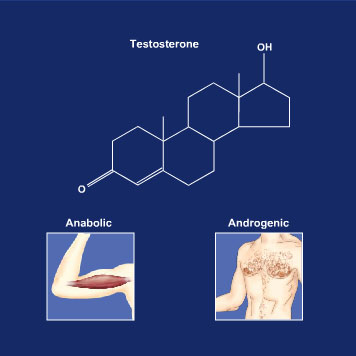Steroids1 are a class of hormones2 that are synthesized by specific cells or tissues in the body and released into the bloodstream. Steroids are non-polar3 molecules produced from the precursor cholesterol. Four interconnected rings of carbon atoms form the skeleton of all steroids (Figure 1). The type of steroid formed is dependent upon the polar4 hydroxyl groups (OH) attached to the interconnected rings and the synthesizing tissue. Examples of synthesizing tissues, the corresponding steroids, and some of their many functions are listed below.
Figure 1 The general structure of a steroid molecule is shown. Different steroids are defined by the location of polar hydroxyl groups (OH) attached to the C atoms within the rings.

Adrenal gland
glucocorticoids (cortisol) – maintain blood glucose during stress, anti-inflammatory
mineralocorticoids (aldosterone) – regulate kidney function (water retention)
Ovaries
estrogen – promotes endometrial cell (uterine) proliferation
progesterone – promotes endometrial cell differentiation
Testes
testosterone – stimulates sperm production, promotes muscle growth
Most steroids are used for medicinal purposes, especially the glucocorticoids, which are powerful anti-inflammatory agents. However, due to very serious side effects from long-term use (such as weight gain, bone density loss, increase in blood cholesterol levels, and liver disorders), they are only used as a last resort. Estrogen and progesterone are used in birth control pills and also in post-menopausal women to replace what is lost during aging. Testosterone (Figure 2) is an anabolic steroid, which promotes growth of muscle tissue. “Anabolic” literally means to build up tissue and it refers to the retention of nitrogen atoms in the body reflecting an increase in protein synthesis and/or a decrease in protein breakdown. While testosterone may be used in some clinical situations (e.g. testosterone-deficient men), it (or synthetic versions) is used mainly by body builders to increase muscle growth and by athletes to increase muscle growth and performance. Testosterone, like other steroids, has multiple effects in the body. It not only promotes muscle growth, it is also an androgen5. It causes the development of male sexual characteristics such as growth of chest and facial hair, growth of the testes and deepening of the voice (Figure 2). Other effects of testosterone include acne, fluid retention, increased libido, aggression, and other psychological disturbances.
Figure 2 The structure of testosterone is shown. This steroid, synthesized in the testes, has both anabolic and androgenic properties.

Definitions:
1 a class of hormones synthesized from cholesterol by specific cells in the body. They are powerful compounds that alter genetic function, causing numerous effects in the body.
2 chemicals in the body that are synthesized in one tissue and secreted into the bloodstream for actions in tissues some distance away. They regulate many physiologic functions.
3 a chemical property of a substance that indicates an even distribution of charge within the molecule. A non-polar or non-charged compound mixes well with organic solvents and lipids but not with water.
4 a chemical property of a substance that indicates an uneven distribution of charge within the molecule. A polar substance or drug mixes well with water but not with organic solvents and lipids. Polar or charged compounds do not cross cell membranes (lipid) very easily.
5 a steroid hormone such as testosterone that is masculinizing (deepens voice, produces facial & chest hair, sperm production)
